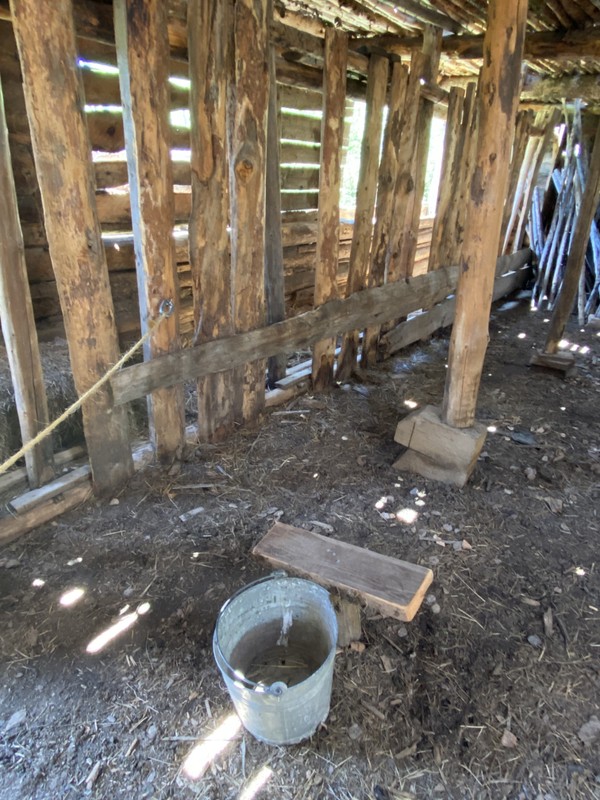Rowley Homestead Milking Barn
Introduction
Text-to-speech Audio
Fred used this barn to milk and sometimes shelter his cows. Similar to the goat barn, this space was likely not occupied by cows unless they were being milked or it was cold or snowy outside. Fred built five stanchions out of wood planks and tree trunks to aid in the milking process. The cows stuck their heads through the wooden slats to reach the hay in the manger. Then Fred closed the slats around them, ensuring that the cows could not move around while being milked. Based on the number of stanchions, Fred had at least five milking cows.
Images
The exterior of the milking barn with the door open.

Interior of the milking barn, featuring stations to hold the cows in place, a milking stool, and a bucket.

Backstory and Context
Text-to-speech Audio
Cows were the source of many important products on a homestead or ranch during the late nineteenth and early twentieth centuries. Raw milk contains both milk and cream. These two products can be separated and sold or used to make other dairy products. Cream, for example, can be churned into butter and sold. Fred kept a small portion of his cows’ dairy products for himself, but the majority was sold or bartered in town. Fred’s cows were likely primarily dairy cows as milk is profitable, but it’s possible that when needed or when they stopped producing milk, the cows were slaughtered for beef.
Although we cannot know the exact number of cattle Fred raised, we do know that he could not sustain a large herd or ranch as he lacked the water rights to the land. This meant that he could not divert Pole Creek (which is located down the hill from the Rowley Homestead) to water his crops or his animals. He also could not use the creek to irrigate his land or dig a well. The Just family owned the water rights to Pole Creek. Their ranch is also located at Snow Mountain Ranch near the craft shop building. They allowed Fred to have “bucket rights” to the water, meaning that he could pull water out in buckets and use it on his homestead. The windmill in the field behind the barns was donated to the YMCA after Fred’s time, as he could not legally use a machine like that to pull up water.
The lives of Fred and the Just family demonstrate the differences between homesteaders without water rights and those with rights. Fred struggled every day to make ends meet, but without water rights he was never successful. In 1939 he fell behind on his taxes and sold his property to Della Just. She allowed him to stay as a tenant farmer until he left between 1953-1954. He died in 1957. The Just family, in contrast, was very successful. With water rights they created a profitable haying operation which Della and, later, her son Rudy operated until the early 1980s. For homesteaders in the West, it did not matter how hard they worked if they did not have water rights, success would always be elusive. They simply could not grow enough crops or raise enough stock to make ends meet.
Sources
Archives of YMCA of the Rockies, Snow Mountain Ranch Collection, Rowley Homestead folders.
